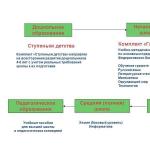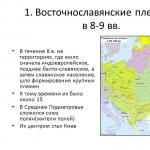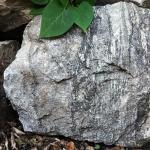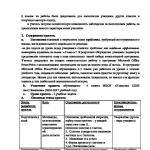Double crown of ancient egypt. The double crown of the pharaoh What was the name of the double crown worn by the Egyptians
What was the double crown on a pharaoh called? and got the best answer
Answer from Alrami[guru]
Atev - a double crown, decorated with symbols of Egypt - a kite and a snake (uraeus). As a sign of the power of the pharaoh, it existed already in the 30th century BC. e.
Answer from 2 answers[guru]
Hello! Here is a selection of topics with answers to your question: What was the name of the double crown on the pharaoh?
Answer from Rain drop[guru]
millet
Answer from Withstand[guru]
millet
Ancient Egypt costume
Hats
Since most Egyptians wore wigs, their headdresses were quite simple. Slaves and peasants, working in the fields, covered their heads with scarves or small linen caps. Noble people wore such hats, embroidered with beads, under their wigs.
The following types of crowns were known: 1) the white crown of Upper Egypt (khedzhet), resembling a pin or a bottle in shape; 2) the red crown of Lower Egypt (deshret), which was a truncated inverted cone with a flat bottom and a high raised back; 3) double crown (pshent), which combined the first two and symbolized the unity of the country; 4) blue with red ribbons "combat crown"; 5) "Amon's crown" of two feathers with a golden disk between them; 6) atef crown; 7) "reed crown" (hemhemet) - a complex structure of golden feathers, ram's horns, snakes and solar disks; and etc.
Judging by the surviving sculptures and reliefs, there were up to 20 varieties of crowns (unfortunately, not a single authentic ancient Egyptian crown has survived to our time). An obligatory accessory of any royal headdress was the uraeus - a golden image of a cobra, which was a symbol of the goddess Wadzhet, the patroness of Lower Egypt. It was placed over the forehead and sometimes supplemented with the golden head of a kite - the sign of Nekhebt, the goddess of Upper Egypt.
The priests in the temples during the rituals put on painted plaster masks depicting the gods. So, the priests of the god Thoth wore masks in the form of the head of the sacred ibis bird, the priests of Anubis - in the form of the head of a jackal, etc.
Ancient Egypt is fraught with many secrets and mysteries. He left behind magnificent monuments, frescoes, sculptures, utensils, jewelry, numerous papyri ... It would seem that there is everything to study the history of Ancient Egypt! However, for some reason it turns out that new finds, as well as the study of old ones, mostly raise questions rather than provide answers. No wonder Egypt excites the minds of more than one generation of historians, archaeologists, and simply lovers of antiquity.
Perhaps one of the most mysterious and, if I may say so, mystical ancient Egyptian figures are the pharaohs. Their life is described in numerous papyrus scrolls, their images are almost everywhere, their death is still in sight. But how many more answers remain to be found by researchers! After all, even in the simplest - in the appearance of the pharaohs, and then there are no certainties.
Here we want to talk about the headdresses of the ancient rulers of Egypt. However, it is worth noting that not a single surviving crown, known to us from ancient Egyptian frescoes and sculptures, has been found to date! So all the works that touch on this topic are the result of images and descriptions in ancient Egyptian texts, and not of real existence.
Pharaoh
Already at first glance it is clear - this is not just a man, not just a ruler - this is the son of the gods! Literally every little thing should scream about his divine essence, every detail of the wardrobe should contain religious symbols and amulets. Therefore, in relation to the rulers, a kind of dress code was developed, which they had no right to violate.
One of the main rules was the following: the pharaoh could not go out to people with his head uncovered. Therefore, there was a whole service for the rulers, which created various headdresses for them - from a simple scarf and wig to the majestic one. And, I must say, this service worked well!
In the wardrobe of the Egyptian king there were numerous, both for everyday wear and for various celebrations. Among them were the simplest ones - short wigs with a smooth hairdo and wigs with pigtails, wigs curled in the most unthinkable way and decorated with various pendants ... In general, the art of creating wigs in Egypt was at a high level.

On especially hot days (or on religious holidays, or on some special days - you can guess indefinitely) the pharaohs put a nemes on their heads - a striped scarf. The stripes were painted in two colors - blue and gold (at least in most images, the pharaohs are decorated with a scarf of just such a color). Nemes was worn so that it covered the entire head, leaving the ears open. At the back, it was braided into a pigtail, and on the sides, the ends cut in a semicircle were lowered onto the shoulders. To keep the nemes better on the head, it was fixed with a gold ribbon or a gold hoop. By the way, the great sphinx also wears a nemes...

The Egyptian pharaohs had several crowns.
First, this millet- the double crown of the Egyptian pharaohs. Initially, there were two states in the Nile Valley, now they are commonly called Upper and Lower Egypt. The rulers of Lower Egypt wore deshret- a red crown, which had a cylindrical shape with a large protrusion at the back. The kings of Upper Egypt wore a white crown - hedge, made in the form of a high cone. It was believed that the khedzhet is associated with the moon and the lunar deities - Osiris and Thoth. This crown was a kind of conductor between ancestors and descendants, it helped in the afterlife to gain enlightenment, join the dream of deities, find a new life among the stars. With the unification of Egypt, deshret and hedzhet became a single crown - pshent.

 Secondly, this atef or the crown of Horus, a crown believed to be worn by the pharaohs on special days of religious holidays. It was made in the form of a high white cap. Feathers were placed on the sides (they symbolized two truths - life and death), and at the base - ram's horns. Sometimes a solar disk was also placed in the center.
Secondly, this atef or the crown of Horus, a crown believed to be worn by the pharaohs on special days of religious holidays. It was made in the form of a high white cap. Feathers were placed on the sides (they symbolized two truths - life and death), and at the base - ram's horns. Sometimes a solar disk was also placed in the center.
Pshent and atef are quite bulky crowns, so they were most likely used when the pharaoh was just sitting, and he had to sit absolutely still. Eh, the pharaonic lot is not easy, but the posture is the envy of everyone.
A more convenient crown was khepresh- a blue crown adorned with gold plaques. This headdress is also called the crown of war, because. for a long time it was believed that the rulers wore it during military campaigns and parades.
From what materials the royal crowns were made is still unknown. It is believed that the white crown and atef were made of cane, the red and blue crowns were made of leather. However, some Egyptologists immediately notice that the Egyptians did not like leather, considering it as an impure material, and even shoes for the aristocracy were cast from gold. So it remains to be hoped that sooner or later at least one crown will be found, and this find will at least somehow bring certainty to this issue.
But the most important attribute of royal power was not even a crown, but only a small forehead decoration - uraeus - a rising cobra with a swollen collar. It was made of gold or silver, placed in the middle of the pharaoh's forehead, attached to a ribbon, hoop or. Urey was worn with absolutely any headdress - be it a wig, nemes or crown. It was the uraeus for the pharaoh that "what makes him great." According to the Book of the Dead, this symbol served as protection for the king - in case of danger, the snake should spit fire and incinerate the enemies of the ruler. Urey also symbolized the wisdom of the pharaoh, his greatness - he stood guard over the laws of the universe.
After the unification of Egypt, next to the uraeus, they began to place the head of a kite - the protector of the rulers of Lower Egypt. Such a unity of symbols made the pharaohs the rulers of a united country, the incarnations of Horus on earth and Osiris after death. It is these symbols that adorn one of the magnificent images of ancient Egyptian jewelry - the “seshed” diadem, found in the tomb of Tutankhamen.


The art and fashion of Ancient Egypt has always touched me personally, by the way they incredibly gracefully and subtly transferred their traditions from the depths of millennia, from century to century, from era to era, from the Stone Age to the Age of Iron, carefully weaving primitive beliefs and customs into new ones. realities of life.
One of such interesting phenomena that walked through the entire history of Ancient Egypt are the headdresses and crowns of queens and princesses. However, royal insignia are the most conservative part of what I called art and fashion above, and it is all the more interesting to trace their history.
The well-known double red-and-white crown Pshent - "Two strong", which symbolized power over the united Egypt and was a symbol of the power of the Kings-Gods, the Egyptian queens, judging by the images, did not wear. There were, of course, exceptions, like Queen Hatshepsut, but she ascended the throne of the country as a male pharaoh.

I want to trace the history of the royal headdresses worn by women who take the place of the queen, that is, the mother of the king or his wife (and not many daughters).
And the most important question that puzzled me when I analyzed this topic, were they?


One of the most characteristic early headdresses that crowned the heads of royal women and goddesses was Neret - a cap in the form of a female vulture. And it was this headdress that formed the basis of the royal crown in later times, a modification worn by Cleopatra, the very last queen of Egypt, who was the beloved of Caesar and Mark Antony.
The cap itself fit snugly to the head, and the neck and head of the Vulture protruded above the forehead of the queen, in its claws the bird clutched the sign of eternity Shen.
Why was the neck placed on the beautiful heads of Egyptian queens? Or more precisely, its species White-headed Vulture - Gyps fulvus.

Those who are at least a little familiar with Egyptian mythology know that there was such a goddess Nekhbet, who patronized Upper Egypt and was revered in the city of Nekheb. And she was depicted in the form of a female Vulture, and later in the form of a woman, on whose head was a cap-Neret.

Decoration Gold, carnelian, turquoise, glass National Museum The goddess Nekhbet in the form of a vulture, in the crown of Atef, shields with her wings the pharaoh, wrapped in the robe of the death god Osiris
Together with another goddess - Wajit, who patronized Lower Egypt, and was depicted as a cobra, Nekhbet made up a two-pronged image, which was called "Both mistresses." It was an important symbol of royal power. For example, one of the parts of the title of the pharaoh was his "name according to Nebti", which identified him with "Both mistresses."
(This is how it was depicted in hieroglyphs.) Thus, it was emphasized that the pharaoh identifies with himself all the power and fullness of power in united Egypt.
(Approximately 3100 BC, the unification of Upper and Lower Egypt took place, the paired image of Wajit and Nekhbet symbolized power over both parts of the country).

Image of Nekhbet in the form of a kite with a white crown of Upper Egypt and Wajit in the red crown of Lower Egypt
An image of the goddess Wajit in her snake form, attached to the forehead of a headdresspharaoh, called Uraeus. And often next to Wajit was Nekhbet.

Wadjit, in the form of a uraeus, together with Nekhbet
on the forehead of Tutankhamun's mask. The pharaoh's striped scarf was called Nemes.

Pharaoh Ptolemy I
X
crowned millet between the goddesses Wajit and
Nekhbet. Temple of Horus at Edfu. On both the goddess Neret with the head of a Vulture

Wadjit in the red crown of the deshret of Lower Egypt and Nekhbet in the crown of Upper Egypt hedzhet, with staffs entwined with snakes in their respective crowns. In the center is Isis with the infant Horus among the reeds. Temple in Dendera
By the reign of Pharaoh Nyuserre (Vdynasty) refers to one of the early images of the modification of Neret, which has in the frontal part not a head of a vulture, but an uraeus, which is explained by the fact that in a particular case, not Nekhbet, but the snake goddess Wajit is depicted in an anthropomorphic form.
Reliefs from the pyramidal complex of King Pepi II (VI Dynasty) also show the goddesses Wajit and Nekhbet in anthropomorphic form and in the Neret headdress, worn over a classic three-part wig. The main visual difference of both goddesses from each other (except for the names inscribed above them) is the only element of their headdress: Nekhbet has a vulture head on her forehead, and Wajit has an uraeus snake.

Images of Neret's cap on the heads of the goddesses, which they wear over a three-part wig, appear quite early, already at the time
IV dynasty. it
2639-2506 BC e. (By the way, the same dynasty to which the famous pharaohs the pyramid builders Khufu, Khafre and Menkaur belonged). And the privilege of wearing it belonged mainly to goddesses. The royal women of the era of the Old Kingdom in the images differ from other aristocrats only in their titles. Already at this time, Neret is not only an attribute of the goddess Nekhbet. It is tried on by Wadjet, Meret and other goddesses.

Nekhbet feeding Pharaoh Sakhur from the 5th Dynasty. Cairo, Egyptian Museum. From the mortuary temple of Sahure at Abydos. One of the earliest images of the goddess in the Neret cap.
According to Horapollon (4th century BC), “the genus of vultures… is only female. Therefore, the Egyptians place the vulture as a crown on all female images, and, consequently, the Egyptians use this sign for all goddesses.
».
One of the aspects that the vulture goddess Nekhbet expressed was motherhood. Vultures are very caring parents. In the hieroglyphic writing of Egypt, the identifying sign "Neret" - "Vulture", was also an ideogram for the word "Mut" - "Mother". And they also wrote the name Mut - the great mother goddess, the wife of the supreme creator god in Theban cosmogony - Amon, the patroness of motherhood (accordingly, the name Mut is translated as "Mother").
Mut was not depicted as a vulture, her main appearance was human, and sometimes with a lion's head.
But on her head, she, not infrequently, wore a headdress in the form of a female vulture - Neret, on top of which the Pshent crown was placed.


Mut feeding King Seti I. Relief from the mortuary temple of Seti I at Abydos. 13th c. BC. photo - Viktor Solkin.
Besides the fact that Nekhbet was a mother goddess, she also frightened the enemies of the pharaoh. The word "Neret" - "Vulture", is considered to be derived from the verb "Neri" - "to intimidate". The head of the vulture (or simply the vulture) was used as a determiner for the noun "Nehru" - "intimidation", "horror".
Neret not only frightened the enemies of the pharaoh, but also protected him.
In the Pyramid Texts, Nekhbet calls for the protection of the pharaoh: “May this king N live thanks to his father Atum! May you protect him, Nekhbet! For you have already protected him, Nekhbet, king N, who is in the House of the Noble, who is in June ».
The fact that Nekhbet was depicted as a vulture or a woman with a Neret headdress, over which the white crown of Upper Egypt - Khenzhent was put on, can serve in favor of the fact that this goddess was a kind of female parallel to the falcon-god Horus, whose earthly incarnation was considered to be the pharaoh himself . In her sacred city of Nekhen, Horus of Nekhen was considered Nekhen's husband. According to legend, she was the embodiment of his invisible eye. And by analogy with how Horus clasped the head of the pharaoh, Nekhbet was placed on the head of the queen

Statue of Pharaoh Khafre c. 2500 with Horus
Based on the foregoing, the main functions of Nekhbet were to protect his son-pharaoh, to nurture him, and also to be a formidable intimidator of his enemies.
The most ancient evidence that the headdress of Neret was also worn by queenscan be found on a fragment of a sculptural portrait of the mother (possibly) of King Khafre and a relief depicting the royal wife Khamerernebti II (IVdynasty). However, on the reliefs in the tomb of Meresankh III, the wife of Khafre, this headdress is not found in her iconography. Neret is not found in other images of royal women of this era.
An even more illustrative example is known from the reliefs of the burial complex of the "king's mother" Khentkaus II in Abusir (V dynasty). At the end of the inscription with the title and the name of Khentkaus there is a identifying sign in the form of a figure of a queen sitting on a cube-shaped throne of gods and kings.
On one relief, the queen is shown in a long wig and Neret's cap,
On the other - in a simple wig, but with a urea on his forehead.


The uraeus on the headdress of Khentkaus II is the first reliably established evidence of the use of this important attribute in the iconography of royal women.According to S. Roth, the unique images of Khentkaus II are the only evidence of the era of the Old Kingdom of such a complete assimilation of a woman of the royal family to her divine prototypes (that is, the patron goddesses Nekhbet and Wajit).
Starting from the 5th Dynasty, the headdress in the form of a vulture can be considered as a characteristic accessory of the mother of the reigning king, or the mother of the heir to the throne. This observation is best illustrated by a miniature alabaster figurine of the queen-mother Ankhesenmerir (Ankhesenpepi) II in the Neret cap, holding the child king Pepi II on her knees.OK. 2288-2224 or 2194 BC 6th dynasty


Queen Ankhnesmerira II and her son Pharaoh Piopi II
She wears a striped wig and a headdress in the form of a royal vulture with outstretched wings; the bird's head, now lost, was made separately from metal (possibly gold) or stone and inserted into a hole in the front of the statue.In the reign of Pepi II, the wearing of a headdress in the form of a vulture, which was probably at first the exclusive privilege of the queen mother, extended to the royal wives in general.
Clear evidence that the headdress in the form of a vulture became an attribute of both the ruling and the future royal mother no later than the era of the Old Kingdom is provided by the stele of King Sebekhotep III (XIII dynasty). On the stele, the mother of King Iwahetibu and his wife Senebhenas are shown in headdresses in the form of a vulture, while the princesses depicted in the lower case wear uraeus.
From the beginning of the era of the New Kingdom (XVI-XI centuries BC), the headdress in the form of a female vulture becomes the main type of headdress for the mothers and spouses of the king.
Well, already from the middle of the XVIII dynasty (XIV century BC), coming from the Old Kingdom, the combination of a three-part wig and Neret's cap became noticeably more complicated. From now on, a three-part blue wig covers the chased Neret, the head of the vulture on the cap either replaces the uraeus, or is framed by two uraeus, and the cap itself is complemented by a crown with a sun disk and two stylized feathers of a falcon or ostrich - the so-called crown of Shuti. They were most likely made of metal (copper or gold).
Double crown or millet Ancient Egypt consisted of the Red and White crowns. She pointed to the unlimited power of the pharaoh on the territory of all of Egypt, Lower and Upper.
The double crown bore the emblem of the Egyptian cobra known as uraeus, which symbolized power in Lower Egypt and Upper Egypt.
Presumably, the double crown was invented by Pharaoh Menes at the beginning of the dynastic period (3100 - 2686 BC). However, the first pharaoh to wear a double crown was Jet.
Unfortunately, the Egyptian original of the double crown was not found during archaeological excavations, so the exact materials from which it was made are unknown. It was probably cloth and leather.
Wearing a double crown was the privilege of Horus and Aten, who were of particular importance to the power of the pharaoh.
Upper Egypt and the White Crown
Upper Egypt, which is in the southern part, is separated from Lower Egypt and is located along the Nile River. The northern part of Upper Egypt is also known as Middle Egypt.
The capital of Upper Egypt was called Nekhen. Nekhen was also the religious center of the cult of Horus, one of the oldest ancient temples was located here, which was important even during the decline of the city. There is a necropolis in Nekhen, which contains about 100 tombs, many of which are the oldest in ancient Egypt and are decorated with colorful drawings.
Upper Egypt is associated with the White Crown or Hedzhet. Although little is known about her origins: imagecan be seen on many Egyptian statues and even drawings in Narmer's tomb.
Often Nekhbet is depicted with a white crown, since she patronized Nekhen and Upper Egypt. Nekhbet is associated with the home of the famous oracle in ancient Egypt. In the city was the "City of the Dead" - a necropolis. The priestess of the temple was called "Mii", which means "mother" in translation. She wore an image with the wings of a vulture emitting Nekhbet.
Lower Egypt and the Red Crown
Lower Egypt, which is located in the north of the African continent, was formed after the creation of a separate state of Upper Egypt, which is located in the south, on the banks of the Nile River.
Lower Egypt was also known as Ta-Mehu or "the lands of the papyrus" and was divided into twenty districts called nomes.
Lower Egypt was united, the red crown of the pharaohs became a symbol of power in it. It was also known as Deshret and it has been suggested that it was originally made of copper, reeds, cloth and leather.
Wearing a red crown, the Egyptian kings thus demonstrated that they were the successors of Horus, the true ruler in Lower Egypt. Some religious cults also wore a red crown, including Buto and Neith.
The red crown, combined with the white crown of Upper Egypt, was a single symbol of power throughout ancient Egypt.
Crown (from Latin corona - wreath, wreath) - a headdress, which is a symbol of monarchical power. Crowns were made from various precious metals (usually gold) and decorated with precious and semi-precious stones.
Portrait of Charlemagne by Albrecht Dürer
in ancient Egypt, the double crown of the pharaoh, decorated with the symbols of Upper and Lower Egypt - a kite and a snake-uraeus.

And after in 3200 BC. Lower and Upper Egypt united, the pharaohs had a white-red double crown. Another headdress of the pharaoh was called “klaf-ushebti”, its components were ribbons, a large piece of striped fabric and a hoop with a uraeus (snake).




Pharaoh in the white crown of the South
Crowns can have a different shape: caps, crowns, hoops crowned with leaves, teeth or plates.

Friedrich III King of Austria.

The crown is placed on the helmet or, as in state emblems, directly above the shield (for example, the princely crown in the coat of arms of Liechtenstein). The crown in the coat of arms is the most common class of heraldic signs of dignity, indicating the feudal status of the owner of the coat of arms. There are many varieties of crowns, any of them can be found in coats of arms, placed on a helmet, above a shield or above a mantle.

Jean_Paul_Laurens_Le_Pape_Formose_et_Etienne_VII_1870

Richard_II_of_England
Depending on the title of their owner, the crowns are divided into:
imperial,
royal,
PRINCE CROWN
(German: Fürstenkrone), an open crown depicted on German coins. feudal principalities (see Prince) and consisted of a gold, jeweled hoop with 5 visible teeth (3 sheets, 2 balls) and 3 visible pearl-adorned bows, connected at the top by a power and covering a purple cap.
ducal,
county, etc.

1) Monomakhovskaya,
2) the Kingdom of Kazan,
3) Mikhail Fedorovich,
4) Peter I Alekseevich,
5) Ivan V Alekseevich,
6) Elizabeth Petrovna,
7) Catherine I,
8) Anna Ivanovna,
9) Large imperial crown,
10) Crown of the Empress.
There is also a papal crown - tiara.

Tiara
The appearance is attributed to the states of the Ancient World (Ancient Egypt, Ancient Rome, Sumer). They were very common in the states of Europe during the period of developed feudalism (since the 11th century). In Rus', the cap of Monomakh was used as the crown of the Grand Duke, later the tsar, under the emperors - the Great Imperial Crown.
Cap of Monomakh. Drawing from the early 1830s, F. G. Solntsev

Drawing of the Great Imperial Crown

Coronation, crowning is a formal procedure, symbolizing the acceptance by the monarch of power and its attributes (throne, crown, scepter, etc.). Does not coincide with the moment of the beginning of the reign (death or abdication of the predecessor, election). In European Christian culture, coronation is a religious ceremony accompanied by a rite of anointing to the kingdom (Old Testament origin).
Jean Fouquet. "Coronation of Charles VI the Mad in Reims Cathedral (November 4, 1380)"

In the Middle Ages, the monarchs of some countries were crowned almost immediately, within days, or rarely weeks, after the beginning of the reign. The reason for this was that the uncrowned monarch was considered illegal in many medieval countries, without grace; the true king of France was to be crowned in Reims Cathedral and anointed from a special vessel (ampoule).

Louis IX - King of France

Theodosius the Great
In Byzantium, the coronation of co-emperors was timed to coincide with Easter. In modern times, after the death of a predecessor, many months or a year of mourning began to be declared, which prevented an immediate coronation. For reasons of auspicious omens, the coronation was henceforth timed to coincide with spring or summer.

Francis II - the last emperor of the Holy Roman Empire
In Christian countries, starting from the 5th century (Byzantium, and then the Western kingdoms), the highest church hierarch usually performed the crowning on the head of the monarch, but many monarchs (almost all Russian, Napoleon I, some British) only took the crown from the hierarch and placed it on themselves.
Napoleon in full imperial garb

Regalia of Russian emperors

The crown is placed on the helmet or, as in state emblems, directly above the shield (for example, the princely crown in the coat of arms of Liechtenstein). The crown in the coat of arms is the most common class of heraldic signs of dignity, indicating the feudal status of the owner of the coat of arms. There are many varieties of crowns, any of them can be found in coats of arms, placed on a helmet, above a shield or above a mantle.

Karl Reichel-portrait of Empress Alexandra Feodorovna
The custom of decorating a helmet with a crown appeared among the knights in the 15th century. Crowned helmets were worn during tournaments, especially in Germany, where a crowned helmet was considered a sign of nobility. Often the crown is not a sign of royal or princely dignity, but performs a purely decorative function. This heraldic crown, or diadem, is placed on the helmet as a crest, supporting the crest itself in place of the windmill, or together with it, located on top.

Portrait of Ludwig I, King of Bavaria
In Russian heraldry of the XVIII - early XX centuries. the coats of arms of all the sovereigns who reigned after Catherine II contained the image of her Big Diamond Crown, with which each of them was crowned the kingdom. The princely title corresponded to the so-called. a princely hat with a red or crimson (purple) top protruding above the ermine edge.

Portrait of Empress Catherine II
The count's crown of dignity with nine pearls did not differ in any way from its German prototype, and the baron's crown repeated a similar sign of dignity adopted in French heraldry - a tall gold hoop expanding upwards, once entwined with a pearl thread. The noble crown, like the German variation corresponding to it in rank, had three leaf-shaped prongs with two pearls between them. Images of crowns of different types in accordance with titles of nobility.

Portrait of Emperor Nicholas II
In order to streamline the creation of coats of arms in the Russian Empire, in 1857 Baron Köhne drew up rules for decorating the coats of arms of provinces, regions, townships, cities and towns. They were approved by the Highest on May 7, July 4 and 16 of the same year.

Portrait of Empress Maria Feodorovna.
The rules include: the classification of heraldic crowns above the shields, decorations (wreaths) around the shields, entwined with appropriate ribbons, and the method of indicating provincial affiliation - in the free part of the shield.

Portraits of Emperor Nikolai Alexandrovich
The imperial crown (model 1857) was established for the capitals of the empire (St. Petersburg and Moscow) and provinces. Ancient royal (sample of 1857) - for cities that had the status of city administration, regions and counties. Ancient royal, crowned with a double-headed eagle - for cities that had the status of city administration and fortresses.

Portraits of Empress Eugenia
Cap of Monomakh - for the ancient Russian cities that were the capitals of the Grand Dukes (Kyiv, Vladimir, Novgorod, Tver, Yaroslavl, Ryazan, Smolensk, etc.); for Kazan and Astrakhan - the corresponding "nominal" hats (crowns).

MARIA FYODOROVNA
Empress of Russia, wife of Alexander III (since October 28, 1866), mother of Emperor Nicholas II.

Maria - Queen of Romania
After the assassination of her husband Alexander in 1934, Maria became regent for her minor son, King Peter II of Yugoslavia.

Maria - Queen of Romania
In 1945, after the proclamation of Yugoslavia as a Socialist Republic and the expulsion of the king, the royal family went to London. Maria died there on June 22, 1961.

Eleanor
Alienora (Alienor, Allenora) Aquitaine
At the age of 15, after the death of her father and brother, Eleanor became the owner of the Duchy of Aquitaine, which occupied vast territories in southwestern France.

Eleanor of Aquitaine
After the dissolution of her marriage with Louis, on May 18, 1152, Eleanor married Count Henry of Anjou, who on October 25, 1154 became King of England - Henry II Plantagenet. The vast Aquitanian lands - her dowry - four times the size of the possessions of the Capetians, became English. According to a number of scientists, it is in the history of the marriage of Eleanor of Aquitaine that one should look for the origins of the war, which received in the 19th century. the name of the Centenary. From the first marriage, Eleanor of Aquitaine had two daughters, from the second - five sons, among them - the king-knight Richard the Lionheart.

MARIA THERESIA
Maria Theresia (German: Maria Theresia, May 13, 1717 - November 29, 1780) - Archduchess of Austria, King of Hungary (that's right, because Hungary, in principle, cannot be ruled by a woman) from June 25, 1741, Queen of Bohemia from October 20, 1740 (had these titles personally, by inheritance) and the Empress of the Holy Roman Empire (as the wife and then the widow of Franz I Stephen of Lorraine, elected emperor in 1745). Founder of the Lorraine branch of the Habsburg dynasty.

Coronation portrait of Elizabeth I
Elizabeth I (September 7, 1533 - March 24, 1603), Queen Bess - Queen of England and Queen of Ireland from November 17, 1558, the last of the Tudor dynasty. She succeeded to the throne after the death of her sister, Queen Mary I.
The reign of Elizabeth is sometimes called the "golden age of England", both in connection with the flourishing of culture (the so-called "Elizabethians": Shakespeare, Marlowe, Bacon, etc.), and with the increased importance of England on the world stage (the defeat of the Invincible Armada, Drake, Reilly, East India Company).

Anna Yaroslavna 6th Queen Consort of France
the eldest of the three daughters of the Kyiv prince Yaroslav the Wise from marriage to Ingegerda of Sweden, the wife of the French king Henry I and the queen of France.

Emperor of China. Guangxu

Pu Yi,

Edward III, who ruled England in the 14th century

Portrait of the Spanish king

Portrait of a King (Magician)

King of England Richard I Plantagenet

Jan Matejko captures Mieszko

Bonaparte Joseph
Now, as a rule, monarchs wear crowns only on especially solemn occasions.






